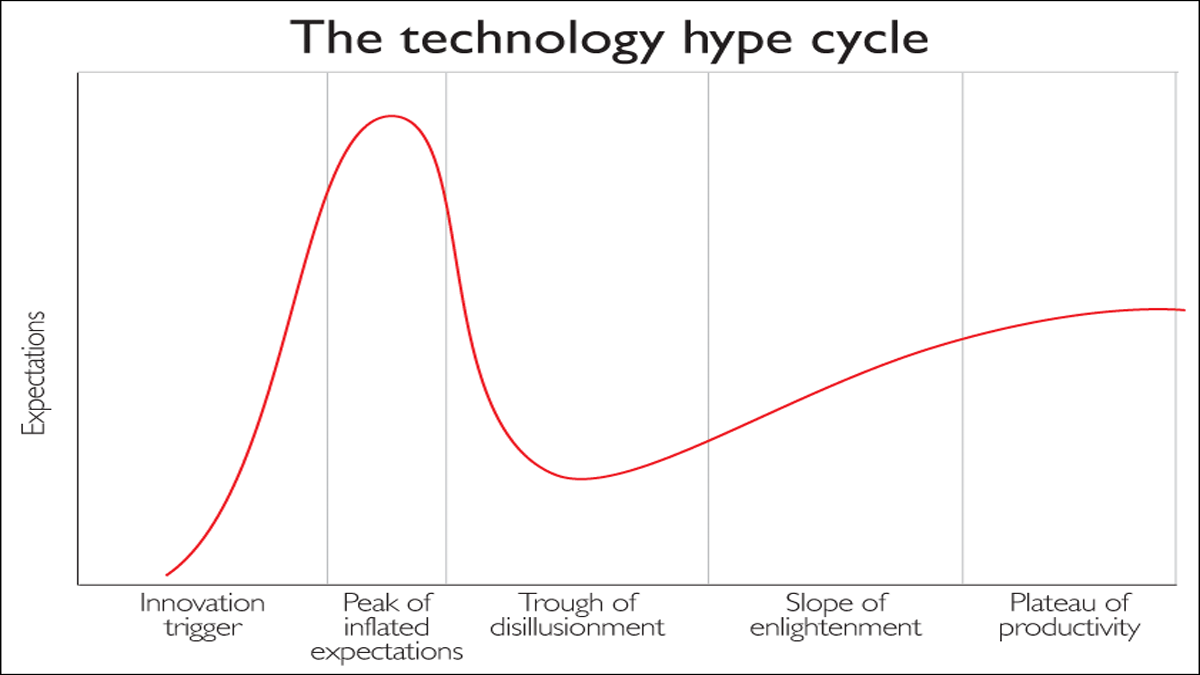The hype cycle: when to buy into tech
Although not intended to be a predictor of investment returns, says Matthew Partridge, the technology hype cycle may be a useful guide to what to expect.


New technology can be a risky business. From the railway mania of the 1840s to the technology bubble of 1999-2001, paper fortunes have been made and lost almost overnight. Indeed, the boom-bust-recovery cycle has played itself out so many times that Gartner, a leading technology research firm, has developed a five-stage "hype cycle" against which it monitors emerging technologies. Although this model is not intended to be a predictor of investment returns, but may be a useful guide to what to expect.
The first stage of the hype cycle is the "innovation trigger", when a new technology is discovered. Initially it is only of interest to the scientists and to a few entrepreneurs. The public remain either unaware or sceptical, with the exception of venture capitalists and specialist investors.
Some firms may start to commercialise the technology, but investment opportunities are limited. For example, in the case of the internet it wasn't until the publication of The Internet Report by Morgan Stanley in 1995 that people started to pay attention.
MoneyWeek
Subscribe to MoneyWeek today and get your first six magazine issues absolutely FREE

Sign up to Money Morning
Don't miss the latest investment and personal finances news, market analysis, plus money-saving tips with our free twice-daily newsletter
Don't miss the latest investment and personal finances news, market analysis, plus money-saving tips with our free twice-daily newsletter
The second stage is the "peak of inflated expectations". This is where investors start pumping money into the sector to the point that it becomes wildly overvalued, while people start making unrealistic projections about the economic impact of the technology.
Initially, some of these investments are sensible, but as the bubble expands, people invest wildly out of a desire not to be left behind. During the internet bubble, it became fashionable for firms to rebrand as "dotcoms", while some people were leaving their jobs to speculate in technology stocks.
The third stage is the "trough of disillusionment". This is where people lose patience with a technology that fails to develop as hoped, or they realise that their expectations are unrealistic. Investors stop putting money into the sector and wind up existing companies. The value of the sector plunges as investors shun the entire sector. Between March 2000 and October 2002, the tech-heavy Nasdaq lost more than 75% of its value.
The fourth stage is the "slope of enlightenment". The investment during the first two periods begins to pay off, resulting in useful products. Firms begin to reinvest in the technology, while investors take a second look at the sector. This began to happen to the internet in the mid-2000s. The value of those companies that managed to survive stage three begins to recover.
Finally, we reach the "plateau of productivity" as the technology matures as has happened in recent years with the internet.
There are clearly two ways to make money during this cycle. The first and most lucrative is to be lucky enough to identify emerging technologies that could have a huge economic impact and then invest in them, selling out once they have become overvalued.
However, early-stage investing is often hard, due to a lack of opportunities. So it's easier to find a sector that has fallen out of favour and become undervalued in other words, focusing on the third stage. Naturally, the worst time to invest is at the top of the peak of inflated expectations.
Get the latest financial news, insights and expert analysis from our award-winning MoneyWeek team, to help you understand what really matters when it comes to your finances.

-
 Investors will reap long-term rewards from UK equities
Investors will reap long-term rewards from UK equitiesOpinion Nick Train, portfolio manager, Finsbury Growth & Income Trust, highlights three UK equities where he’d put his money
-
 The graphene revolution is progressing slowly but surely
The graphene revolution is progressing slowly but surelyEnthusiasts thought the discovery that graphene, a form of carbon, could be extracted from graphite would change the world. They might've been early, not wrong.